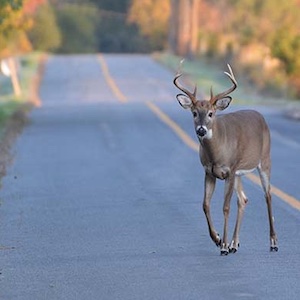
Exploring Spatial and Temporal Trends in Roadkill to Improve and Propose Mitigation Structures
Research Location:
Implemented: Northern Virginia, USA
Conservation Partners:
Virginia's Department of Wildlife Resources, Department of Transportation, Department of Forestry, and the Department of Conservation
Student Researcher (2024)
Sofia Politte, Major: Integrative ConservationStudent Researcher (2024)
Cayley Santella, Major: Integrative ConservationStudent Researcher (2023)
Alexa Busby, Major: Biology; Major: Environmental ScienceFaculty Mentors
Dr. Robert Rose and Dr. Matthias LeuProject Description
Working alongside the Virginia Department of Wildlife Resources, W&M students are identifying priority areas in northern Virginia where we can feasibly and effectively mitigate animal-vehicle collisions needed to conserve wildlife, reduce human injuries, and reduce billions spent on property damage.
Nearly 2 million animal-vehicle collisions occur every year in the U.S., resulting in approximately 200 human deaths, 26,000 injuries, at least $8 billion in property damage and other costs, and significant threats to wildlife movement and population dynamics (Pew Charitable Trust). With the rapid land development in northern Virginia, there is an urgent need to mitigate animal-vehicle collisions to promote road safety and conserve biologically diverse wildlife corridors. Virginia's Department of Wildlife Resources has been tasked with creating a Wildlife Corridor Action Plan in collaboration with the Virginia Department of Transportation, the Department of Forestry, and the Department of Conservation and Recreation. To ensure that this Action Plan is effective in meeting safety and conservation goals, there is an urgent need for more information on where collisions are occurring and where mitigation efforts may be feasible across Virginia.
In 2023, Alexa Busby mapped priority areas for mitigation utilizing collision data and metrics for mitigation success across Loudon County. Alexa also worked with Virginia's Volunteer Master Naturalists to explore how citizen scientists can support efforts to identify and monitor mitigation efforts.
Building upon this successful research, Cayley Santella'25 and Sofia Politte'26 examine the efficacy of mitagating factors at the proposed priority sites. The students identify successful mitigation strategies through a review case studies from other regions and will design and deploy camera traps to explore wildlife species at the sites and their behavior at the mitigation sites. The team also explore ways in which citizen science can support mitigation efforts, and will design a pre-post monitoring strategy to help support effective the animal-vehicle collision mitigation efforts.
Project ID - Format
23-013-23 - CRP Year
23-013-24 - CRP Year














